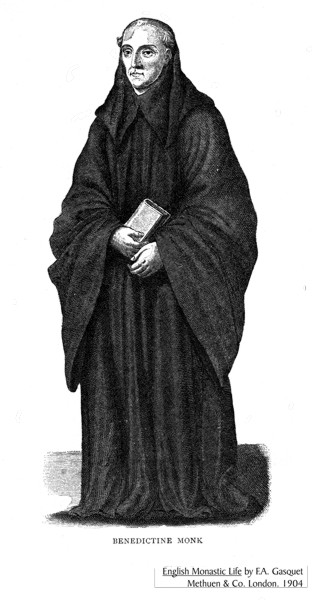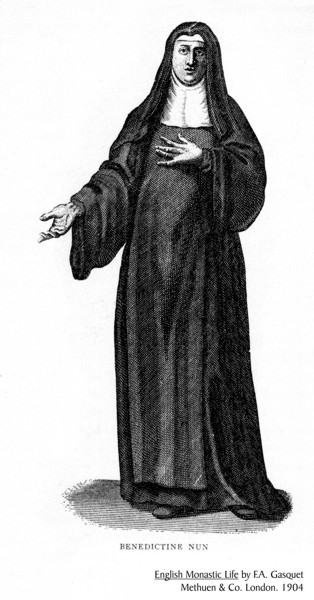Much information about
the Benedictine Order
can be found on the
internet. What I hope to
do is complement existing information by adding information from Abbot
Gasquet's book English
Monastic
Life. Gasquet published the book through The Antiquaries
Book
series in
1904. It is now out of print and not generally available.
There may
be a number of factual errors in the text, or points on which
historians or theologians do not agree. You will also find
Benedictine Links below.
Gasquet's text>>
|
 |
 |
Benedictines
St.
Benedict, justly called the Patriarch of Western
Monachism, established his rule of life in Italy
; first at Subiaco and subsequently at Monte Cassino about A.D.
529. The
design of his code was, like every other rule of regular life, to
enable men to
reach the higher Christian ideals by the helps afforded them in a
well-regulated monastery. According to the saint's original
conception,
the houses were to be separate families independent of each
other. It was
no part of his scheme o establish a corporation with branches in
various
localities and countries, or to found an "Order" in its modern
sense. By its own inherent excellence and because of the sound
common-sense which pervades it, the Rule of St. Benedict at once began
to take
root in the monasteries of the West, till it quickly superseded any
others then
in existence. Owing to its broad and elastic character, and hardly
less,
probably, to the fact that adopting it did not imply the joining of any
stereotyped
form of Order, monasteries could, and in fact did, embrace this code
without
entirely breaking with their past traditions. This, side by side
in the
same religious house, we find that the rule of St. Columba was observed
with
that of St. Benedict until the greater practical sense of the latter
code
superseded the more rigid legislation of the former. Within
a
comparatively short time from the death of St. Benedict in A.D.
543, the
Benedictine became the recognised form of Western regular life.
To this
end the action of Pope St. Gregory the Great and his high approval of
St.
Benedict's Rule greatly conduced. In his opinion it manifested no
common
wisdom in its provisions, which were dictated by a marvellous insight
into
human nature and by a knowledge of the best possible conditions for
attaining
the end of all monastic life, the perfect love of God and of man.
Whilst
not in any way lax in its provisions, it did not prescribe an
asceticism which
could be practiced only by the few ; whist the most ample powers were
given to
the superior to adapt the regulation to all circumstance of time and
places ;
thus making it applicable to every form of the higher Christian life,
from the
secluded cloister to that for which St. Gregory specially used those
trained
under it : the evangelisation of far-distant countries.
The connection between the
Benedictines and England
began with the mission of St. Augustine
in A.D. 597. The Monastery of Monte Cassino
having been destroyed by the Lombards,
toward the end of the sixth century, the monks took refuge in Rome,
and were placed in the Lateran, and by St. Gregory in the church he
founded the
honour of St. Andrew, in his ancestral home on the Coelian Hill.
It was
the prior of St. Andrew's whom he sent to convert England.
With the advent of the Scottish monks from Iona
the
system of St. Columba was for a time introduced into the North of
England ; but
here, as in the rest of Europe, it quickly gave
place to
the Benedictine code ; and practically during the whole Saxon period
this was
the only form of monastic life in England.
English Monastic Life by
F.A. Gasquet. (pages 213-217)
|
Note: The
Benedictine Rule is a book of rules or principles set down by
St. Benedict that regulate how
religious brothers and sisters should live together and conduct
themselves as brethren in a monastery. There were a number of
different 'rules' established over the centuries, but the Benedictine
Rule was the most enduring and familiar to the West.
|
Benedictine Abbeys in
England (for more Benedictine Religious Houses, see the index page):
| Abbotsbury |
Abbey |
|
Dorset.
|
| Abingdon
|
Abbey |
|
Berks.
|
St.
Alban’s (Also see info on shrines.)
|
Abbey
|
|
Herts. |
| Athelney
|
Abbey |
|
Somerset.
|
| Bardney |
Abbey
|
|
Lincoln.
|
| Bardsey |
Abbey
|
|
Carnarvon.
|
| Battle
|
Abbey |
|
Sussex.
|
| St.
Benet’s of
Hulme |
Abbey |
|
Norfolk.
|
| Burton-on-Trent,
or
Modwenstow |
Abbey
|
|
Stafford. |
| Bury
St. Edmunds |
Abbey
|
|
Suffolk. |
| Canterbury,
St. Augustine’s
|
Abbey
|
|
Kent.
|
| Cerne
|
Abbey |
|
Dorset.
|
| Chertsey |
Abbey
|
|
Surrey.
|
Chester,
St.
Werburgh's
|
Abbey
|
|
Cheshire.
|
| Colchester,
St. John’s
|
Abbey
|
|
Essex. |
| Croyland,
or
Crowland |
Abbey
|
|
Lincoln. |
| St. Dogmael’s |
Abbey |
|
Pembroke.
|
| Evesham
|
Abbey |
|
Worcester.
|
| Eynesham
|
Abbey
|
|
Oxford.
|
| Faversham
|
Abbey
|
|
Kent.
|
| Glastonbury |
Abbey
|
|
Somerset.
|
| Gloucester,
St. Peter’s |
Abbey
|
|
Gloucester.
|
| Humberston,
or
Hunston |
Abbey
|
|
Lincoln.
|
| Hyde,
or
Newminster, Winchester |
Abbey
|
|
Hants.
|
| Malmesbury
|
Abbey
|
|
Wilts.
|
| Milton,
or Middleton |
Abbey
|
|
Dorset.
|
| Muchelney
|
Abbey
|
|
Somerset.
|
| Pershore
|
Abbey
|
|
Worcester.
|
| Peterborough
|
Abbey
|
|
Northants.
|
| Ramsey
|
Abbey
|
|
Hunts.
|
| Reading
|
Abbey
|
|
Reading.
|
| Selby
|
Abbey
|
|
Yorks.
|
| Sherborne
|
Abbey |
|
Dorset.
|
| Shrewsbury
|
Abbey
|
|
Salop.
|
| Spalding
|
Abbey |
|
Lincoln. |
| Tavistock
|
Abbey |
|
Devon. |
| Tewkesbury
|
Abbey |
|
Gloucester.
|
| Thorney
|
Abbey |
|
Cambridge.
|
| Walden
|
Abbey |
|
Essex. |
| Westminster
|
Abbey |
|
Middlesex.
|
| Whitby |
Abbey |
|
Yorks
|
| Winchcombe,
or
Winchelcombe |
Abbey |
|
Gloucester.
|
| Wymondham
|
Abbey |
|
Norfolk. |
| York,
St. Mary’s |
Abbey |
|
Yorks.
|
| Barking
|
Abbey |
Female
House
(Nuns)
|
Essex. |
| Malling
|
Abbey
|
Female
House
(Nuns) |
Kent.
|
| Romsey
|
Abbey
|
Female
House
(Nuns) |
Hants.
|
| Winchester,
St. Mary’s |
Abbey
|
Female
House
(Nuns) |
Hants.
|
|
Benedictine Links:
Corrections,
questions?
 |
|
Historyfish
pages, content, and design copyright (c) Richenda
Fairhurst, 2008
All rights reserved. No commercial permissions are
granted.
The Historyfish site, as a
particular and so
unique "expression," is copyright. However, some (most) source
material is part of the public domain, and so free of copyright
restrictions. Where those sections are not clearly marked, please
contact me so I can assist in identifying and separating that material
from the Historyfish site as a whole.
When using material from this site,
please keep
author, source, and
copyright permissions with this article.
Historyfish intends to generate discussion
through shared
information and does not claim to provide,
in any way, formal, legal, or factual advice or information. These
pages are opinion only. Opinions shared on historyfish are
not necessarily
the
opinions of historyfish editors, staff, owners or
administrators. Always consult
proper authorities with questions pertaining to copyrights, property
rights, and intellectual property rights.
It is my intent to follow copyright law (however
impossibly convoluted
that may be). Please contact me should any material included here be
copyright protected and posted in error. I will remove it from the
site. Thank you. |
|
